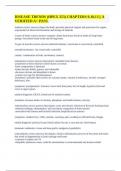DISEASE TRENDS (HPEX 353) CHAPTERS 9,10,13 || A
VERIFIED A+ PASS.
skeleton correct answers shapes the body, provides physical support and protection for organs,
responsible for blood cell formation and storage of minerals
2 types of bones correct answers compact- dense hard tissue found in shafts of long bones
spongy- less dense found at the end of long bones
3 types of muscles correct answers skeletal/voluntary- movement is consciously controlled
smooth/involuntary- not consciously controlled
cardiac- combination of both. involuntary contract
osteoperosis correct answers description: metabolic bone disease.
-proportion of bone mineral to bone matrix is normal.
-bone composition is abnormal
-bones become brittle, porous, and vulnerable
-decrease calcium and phosphate in bones
-women over age 50, postmenopausal
-hereditary? possible other factors are calcium intake, vitamin d deficiency, alcohol, estrogen
deficiency, diet.
symptoms: asymptomatic, fractures, lower back bone pain, loss of height, kyphosis (forward
curve in upper spine)
medical diagnosis: DEXA, blood test for mineral content
treatment: increase intake of calcium, phosphate, and multivitamins, exercise
osteomyelitis correct answers description: acute and chronic infection of the bone forming tissue
-edema (swelling), inflammation, and circulatory congestion of bone marrow
-associated with trauma and bacterial infection (staphylococcus aureus)
symptoms: sudden fever, chills, malaise, sweating, pain, swelling on affected bone, fatigue
medial diagnosis: physical exam, blood culture for mo, x rays and mri, bone biopsy
treatment: antibiotics, tissue and bone grafts, analgesics (painkiller)
osteoarthiritis correct answers description: chronic inflammatory process of the joints and bones
that result in degeneration of joint cartilage and bones
-common in adults over 70
-idiopathic (unknown cause, could be autoimmune or environmental) and trauma related
, symptoms: joint pain, swelling, crepitation (cracking sound)
medical diagnosis: physical examination, x ray
treatment: uncured, physical therapy, local heat, anti inflammatories, physical activity restriction
rheumatoid arthiritis correct answers description: chronic, systemic, inflammatory disease
affecting the synovial membranes of multiple joints.
-autoimmune disease (genetic predisposition)
symptoms: joint pain, malaise, low grade fever, weight loss, fatigue
medical diagnosis: rheumatoid factor blood test, ESR, CBC, synovial fluid analysis, x ray
treatment: anti-inflammatory drugs, corticosteroids, surgery
gout/ gout arthritis correct answers description: chronic disorder of uric acid metabolism
-uric acid (crystals) appear in the synovial fluid of joints (tophi)
- men younger than 30, women (menopause)
-metabolic (genetic) and/or renal problem to clear uric acid
-risk factors- obesity, alcohol, low thyroid function, aspirin
symptoms: sudden onset of joint pain (big toe), renal dysfunction, tophi (lumps in skin formed
by accumulation of uric acid crystals), hyperuricemia (high urea in blood)
medical diagnosis: identification of urate crystals in joint fluids, urinalysis (hyperuricemia), ESR,
x ray (to assess joint damage), physical exam
treatment: best rest, local heat or cold, analgesics (painkiller), corticosteroids (oral or IM), diet +
fluids
prognosis: good can have some complications like kidney stones, renal damage, hypertension
myasthenia gravis correct answers description: chronic, progressive, neuromuscular disease that
produces sporadic weakness and exhaustion of skeletal muscles.
-autoimmune response resulting in the disappearance of receptors for the neurotransmitter
acetylcholine
-more common in women 20-40
-tumors of thymus glands also present in 15% of cases
-aggravated by menses, emotional stress, and infections
symptoms: skeletal muscle weakness, fatigue, blepharoptosis (drooping eyelids), double vision,
dysphagia (difficulty swallowing), dysphasia (difficult speaking), myasthenia crisis (respiratory
distress)




